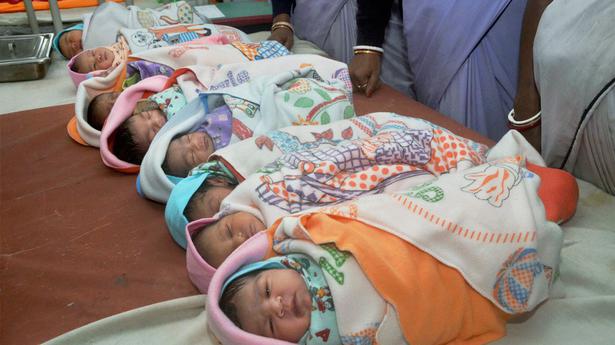
In 2030, deaths in Karnataka will be 12 lakh and births only 10.2 lakh
The Hindu
Karnataka’s Total Fertility Rate falling faster than national trend: Economic Survey
The Total Fertility Rate (TFR) — average number of children a woman would have in the course of her life — in Karnataka has fallen faster than the trend observed nationally.
When the country’s TFR was 3.4 in 1992-93, Karnataka’s was 2.65. Thirteen years later in 2005-06, the State’s TFR had dipped below replacement (the rate at which the population replaces itself) at 2.1. It further dipped to 1.8 in 2015-16 and 1.7 in 2019-21 signifying that the fertility drop has not levelled off yet, according to observations made in the Karnataka Economic Survey 2021-22, which was released recently.
With the percentage of registration for both births and deaths increasing across India, the steep fertility decline is consistent. Data from the survey revealed that the estimated births and gross of infant mortality deaths is stagnating for the last five years, and possibly declining. The total number of deaths in the country is also increasing.
“In Karnataka, the total number of births is reducing in line with fertility having dropped to 1.7 in 2019-21, and possibly 1.5 by 2030. It is very clear that the number of deaths is increasing quite dramatically. If the estimated births decrease by 1% every year — in 2030, the number of actual births could be 10.2 lakh. However, the compound annual growth rate (CAGR) of deaths is almost 7%, which means the number of deaths in 2030 will be close to 12 lakh, overtaking the number of births, leading to a population decline. A detailed analysis is required to create a demographic profile of the State till 2030, so that appropriate targeted policies can be evaluated,” according to findings of the survey.
“Crucially, India’s TFR has plummeted over three decades, and the Indian population is officially below replacement. Global consensus has placed the replacement rate for emerging economies at 2.3, and for the developed world at 2.1. India’s latest TFR, according to National Family Health Survey - 5 (NFHS-5), is 2.0, coming under both replacement rates (of emerging economies and developed world), and officially signifying the country’s high population growth trajectory is over and the population will peak soon,” according to the survey report.
T.V. Sekher, Professor and Head, Department of Family and Generations, International Institute of Population Sciences, Mumbai, said “South Indian States are in an advanced stage of demographic transition whereas several States, such as Bihar and Uttar Pradesh, are still behind. The declining TFR trend is expected. We do not need any policy to bring down fertility,” he asserted.
Pointing out that the number of senior citizens will increase multifold in a couple of decades and social security will be essential, Dr. Sekher said: “We are in the stage of reaping from India’s demographic dividend provided we develop a highly skilled and productive workforce and give them employment opportunities to keep the economic momentum going. This is a big challenge for the country.”











